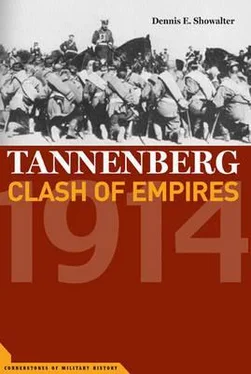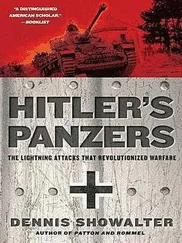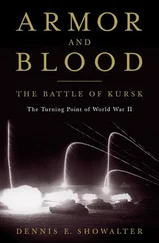On the opposing armies, Bernd Schulte, Die deutsche Armee 1900–1914. Zwischen Beharren und Verändern (Düsseldorf, 1977); and Manfred Messerschmidt, “Preussens Militär in seinem gesellschaftlichen Umfeld,” Geschichte und Gesellschaft, Sonderheft 6, Preussen im Rückblick, ed. H-J Pühle, H-U Wehler (Göttingen, 1980), pp. 43–88; are the best examples of a currently dominant school of thought sharply critical of the German army’s social role and fighting power. David R. Jones, “Imperial Russia’s Forces at War,” in Military Effectiveness, Vol. I, The First World War, ed. A. R. Millett, W. Murray (Boston, 1988), 249–328, is the best readily-available survey of a subject treated at greater length in “Russia’s Armed Forces at War: 1914–1918: An Analysis of Military Effectiveness” (Ph.D. Dissertation, Dalhousie University, 1986). Bruce Menning’s forthcoming Bayonets Before Bullets is a definitive analyses of doctrine, training, and tactics in the Russian army of 1914. Allan Wildman’s two volumes on The End of the Russian Imperial Army (Princeton, 1979) stresses the impact of war on the army’s structure.
Operationally Tannenberg is most familiar to English-language readers from its Russian perspective. Alexander Solzhenitsyn’s August 1914, especially its revised and enlarged edition (New York, 1989), incorporates an historical dimension that makes its case more by weight than by scholarship. W. Bruce Lincoln, Passage through Armageddon (New York, 1986), and Norman Stone, The Eastern Front, 1914–17 (New York, 1975), include up-to-date summary accounts of Tannenberg. Lincoln focusses on the command aspects of Russia’s disaster; Stone emphasizes the army’s structural weaknesses. Of the older secondary accounts, N. N. Golovine, The Russian Campaign of 1914, tr. A. G. S. Muntz (Ft. Leavenworth, Kans., 1933) remains valuable for its copious excerpts from unpublished or obscure Russian accounts. British general Sir Edmund Ironside’s Tannenberg: The First Thirty Days in East Prussia (Edinburgh, 1933), is a professional soldier’s account containing translations of many of the Russian orders whose original texts are in Sbornik dokumentov mirovay voyni na russkom fronte. Manevrenni period 1914 goda: Vostochno-Prusskaya operasiya, ed. Generalny Shtab RKKA (Moscow, 1939), Alfred Knox, With the Russian Army, 1914–1917, Vol. I (London, 1921), incorporates the most familiar description of the 2nd Army’s situation. Jean Savant, Épopée Russe (Paris, 1945), is an emigré apologia for Rennenkampf, nevertheless helpful in explaining the 1st Army commander’s behavior during the Tannenberg campaign.
Material from the German side of the battle line is at least as ample, though less accessible. Hindenburg and Ludendorff both left memoirs, published in English as Out of My Life (London, 1933) and Ludendorff’s Own Story (New York, 1929). Max Hoffmann’s War Diaries and Other Papers (London, 1929); and Hermann von François’s Marneschlacht und Tannenberg (Berlin, 1920), give their respective authors the best of every situation, but are useful retrospectives. Walther von Stephani, Mit Hindenburg bei Tannenberg (Berlin, 1919) offers a junior staff officer’s perspective.
Of the secondary accounts, the German official history, Die Befreiung Ostpreussens, Volume II of Der Weltkrieg (Berlin, 1925), is detailed and reliable on everything that can be verified, but glosses over the problems of command that played such a major role in the campaign. Walter Elze, Das Deutsche Heer von 1914 (Breslau, 1928), despite its title, is a sound analysis of Tannenberg by one of interwar Germany’s finest civilian military historians. The volume is particularly valuable because it reprints many orders whose originals were lost during World War II. Elze’s distaste for what he considers Ludendorff’s unjustified postwar pretensions are as clear as his admiration for Hindenburg.
Theobald von Schäfer, the archivist responsible for Volume II of the official history, used the anecdotal and descriptive material excluded from the larger work as a basis for Tannenberg (Berlin, 1927), a volume in the Reichsarchiv’s series Schlachten des Weltkrieges. This drum-and-trumpet narrative account, constantly contrasting German heroism with Russian incompetence, invites dismissal as Weimar revisionism at its worst. Its extensive citations of sources, since lost, nevertheless make it a rough equivalent of Golovine, at least for the operations against the Russian 2nd Army.
Almost every regiment of the kaiser’s army produced its own history of World War I. These range from simple précis of war diaries and stupefying lists of dates to well-researched, sophisticated accounts by academically trained historians who made full use of diaries, letters, and interviews. Given the extensive destruction of German military archives for the period, these volumes are the best remaining source of information on the wartime army’s domestic economy. Their authors on the whole strove for honesty. In their pages not all the comrades are valiant and not all the officers are above average. The most senior and socially acceptable regiments, those with the largest funds and the richest old comrades’ associations, tended to produce the most detailed, and correspondingly useful, works. For the 8th Army, Franz von Gottberg, Das Grenadier-Regiment Kronprinz (1. Ostpreussische) Nr. 1 im Weltkriege, Vol. I, Die Ereignisse von Kriegsbeginn bis zum 3l.Juli 1916 (Berlin 1927); Alfred Bülowius and Bruno Hippler, Das Infanterie-Regiment v. Boyen (5. Ostpreussisches) Nr. 41 im Weltkriege 1914–1918 (Berlin, 1929); and Wilhelm Reichert, Das Infanterie-Regiment Frhr. Hiller von Gaertringen (4. Posensches) Nr. 59 im Weltkriege 1914/18, Vol. I, 1914/15 (Berlin, 1930) stand out. Moritz Holzmann, Hanseatische Landwehr im Felde (Geschichte des L.I.R. 75), Vol. I, Bewegungskrieg (Hamburg, 1928), casts useful light on the fight of the Goltz Division; and Ernst Zipfel, Geschichte des Dragoner-Regiments König Albert von Sachsen (Ostpr.) Nr. 10 (Zeulenroda, 1933), gives a comprehensive picture of the patrols and skirmishes that made up the cavalry’s still-vital contribution.
Among the many works published since the original appearance of this monograph, in addition to those referred to in the introduction, four specific studies stand out. It is no exaggeration to say that Stig Foerster, “Der deutsche Generalstab und der Illusion des kurzen Krieges, 1871–1914,” Militaergeschicht-liche Mitteilungen, 54 (1995), 61–95; and Terence Zuber, Inventing the Schlieffen Plan (New York, 2003), have between them provoked a fundamental rethinking of German strategy. Annika Mombauer, Helmuth von Moltke and the Origins of the First World War (Cambridge, 2001), is an equally fundamental revision of the Chief of Staff’s role in war planning. And John Sweetman, Tannenberg 1914 (London, 2002), is a model general-audience narrative, complementing the present work rather than competing with it.
Aehrenthal, Alois Lexa, 36, 38, 42, 47
Air reconnaissance, 152–53, 169, 189, 192, 267, 300, 311–12
Alexander III, Tsar of Russia, 19
Alieuv, Eris Khan, 137, 189
Army Bill of 1913 (German), 70–71
Army, French, compared with Germany, 31–32; strategy and tactics, 52–53
Army, German: and strategic planning, 20–22, 25–26, 30–35, 43–46, 59–60, 98, 335–46; and views on war, 58–59; military intelligence, 61–63, 95–98; officer corps, 108–11, 272–73; socialists and, 109–10; regimental system, 111–12, 113–14; as socializing institution, 112–13, 116–17; doctrine and training, 114–15, 124, 164–65; mistreatment in, 115–16; structure of, in 1914, 117–20; tactics, 121–23, 174; reservists in, 123–24, 142–43, 149–50; uniforms and equipment, 148–49; intelligence, 150–51; morale, 252–54; pioneers in, 272–73
Читать дальше












